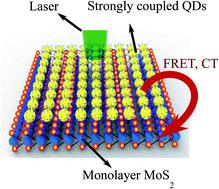当前位置:
X-MOL 学术
›
Nanoscale Adv.
›
论文详情
Our official English website, www.x-mol.net, welcomes your
feedback! (Note: you will need to create a separate account there.)
Strong suppression of emission quenching in core quantum dots coupled to monolayer MoS2
Nanoscale Advances ( IF 4.6 ) Pub Date : 2020-07-06 , DOI: 10.1039/d0na00384k H L Pradeepa 1 , Aveek Bid 1 , Jaydeep K Basu 1
Nanoscale Advances ( IF 4.6 ) Pub Date : 2020-07-06 , DOI: 10.1039/d0na00384k H L Pradeepa 1 , Aveek Bid 1 , Jaydeep K Basu 1
Affiliation

|
Non-radiative processes like energy and charge transfer in 0D–2D semiconductor quantum dot (QD)-transition metal dichalcogenides (TMDs) and other two-dimensional layered materials, like graphene and analogs, leading to strong quenching of the photoluminescence (PL) of the usually highly emissive QDs, have been widely studied. Here we report control of the emission efficiency of core QDs placed in close proximity to the monolayers of MoS2. The QDs are transferred in the form of a high-density compact monolayer with the dot–dot separation, δ as well as the MoS2–QD separation, d, being controlled through chemical methods. While at larger separations we observe some quenching due to non-radiative processes, at smaller separations we observe enhanced emission from QDs on MoS2 as compared to the reference despite the presence of significant non-radiative charge transfer. Interestingly, at small separations δ, we see evidence of strong dot–dot interactions and a significant red shift of QD PL which enhances spectral overlap with the B exciton of MoS2. However, we observe significant reduction of PL quenching of QDs relative to longer δ and d cases, despite increased probability of non-radiative resonant energy transfer to MoS2, due to the enhanced spectral overlap, as well as charge transfer. Significantly we observe that simultaneously the intensity of the B exciton of MoS2 increases significantly suggesting the possibility of coherent and resonant radiative energy exchange between the 0D excitons in QDs and the 2D B exciton in MoS2. Our study reveals interesting nanoscale light–matter interaction effects which can suppress quenching of QDs leading to potential applications of these nanoscale materials in light emitting and photonic devices.
中文翻译:

强抑制耦合到单层 MoS2 的核心量子点中的发射猝灭
0D-2D 半导体量子点 (QD)-过渡金属二硫属化物 (TMD) 和其他二维层状材料(如石墨烯和类似物)中的能量和电荷转移等非辐射过程会导致光致发光 (PL) 的强猝灭通常高发射量子点已被广泛研究。在这里,我们报告了对放置在靠近 MoS 2单层的核心 QD 的发射效率的控制。量子点以高密度致密单层的形式转移,具有点-点分离δ以及 MoS 2 -QD 分离d,通过化学方法进行控制。虽然在较大的分离中,我们观察到由于非辐射过程导致的一些猝灭,但在较小的分离中,我们观察到与参考相比,MoS 2上 QD 的发射增强,尽管存在显着的非辐射电荷转移。有趣的是,在小间距δ处,我们看到了强点-点相互作用的证据和 QD PL 的显着红移,这增强了与 MoS 2的 B 激子的光谱重叠。然而,我们观察到相对于较长的δ和d情况, QD 的 PL 猝灭显着减少,尽管非辐射共振能量转移到 MoS 2的可能性增加,由于增强的光谱重叠,以及电荷转移。值得注意的是,我们观察到同时 MoS 2的 B 激子的强度显着增加,这表明 QD 中的 0D 激子和 MoS 2中的 2D B 激子之间存在相干和共振辐射能量交换的可能性。我们的研究揭示了有趣的纳米级光-物质相互作用效应,可以抑制量子点的猝灭,从而导致这些纳米级材料在发光和光子器件中的潜在应用。
更新日期:2020-07-06
中文翻译:

强抑制耦合到单层 MoS2 的核心量子点中的发射猝灭
0D-2D 半导体量子点 (QD)-过渡金属二硫属化物 (TMD) 和其他二维层状材料(如石墨烯和类似物)中的能量和电荷转移等非辐射过程会导致光致发光 (PL) 的强猝灭通常高发射量子点已被广泛研究。在这里,我们报告了对放置在靠近 MoS 2单层的核心 QD 的发射效率的控制。量子点以高密度致密单层的形式转移,具有点-点分离δ以及 MoS 2 -QD 分离d,通过化学方法进行控制。虽然在较大的分离中,我们观察到由于非辐射过程导致的一些猝灭,但在较小的分离中,我们观察到与参考相比,MoS 2上 QD 的发射增强,尽管存在显着的非辐射电荷转移。有趣的是,在小间距δ处,我们看到了强点-点相互作用的证据和 QD PL 的显着红移,这增强了与 MoS 2的 B 激子的光谱重叠。然而,我们观察到相对于较长的δ和d情况, QD 的 PL 猝灭显着减少,尽管非辐射共振能量转移到 MoS 2的可能性增加,由于增强的光谱重叠,以及电荷转移。值得注意的是,我们观察到同时 MoS 2的 B 激子的强度显着增加,这表明 QD 中的 0D 激子和 MoS 2中的 2D B 激子之间存在相干和共振辐射能量交换的可能性。我们的研究揭示了有趣的纳米级光-物质相互作用效应,可以抑制量子点的猝灭,从而导致这些纳米级材料在发光和光子器件中的潜在应用。











































 京公网安备 11010802027423号
京公网安备 11010802027423号